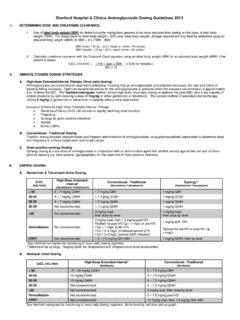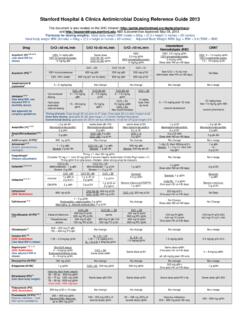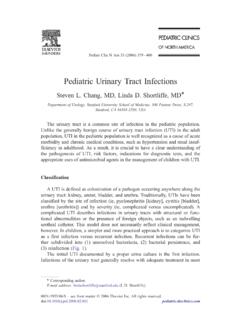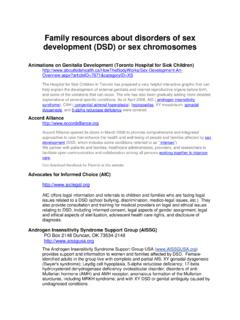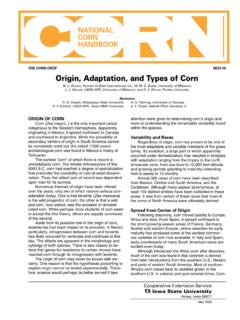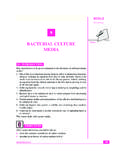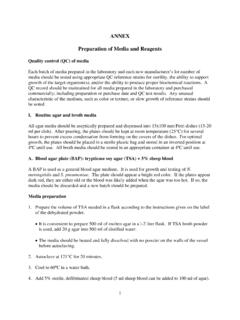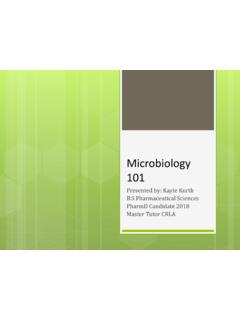Transcription of Pediatric Urinary Tract Infections - Stanford Medicine
1 Pediatr Clin N Am 53 (2006) 379 400. Pediatric Urinary Tract Infections Steven L. Chang, MD, Linda D. Shortliffe, MDT. Department of Urology, Stanford University School of Medicine , 300 Pasteur Drive, S-287, Stanford , CA 94305-2200, USA. The Urinary Tract is a common site of infection in the Pediatric population. Unlike the generally benign course of Urinary Tract infection (UTI) in the adult population, UTI in the Pediatric population is well recognized as a cause of acute morbidity and chronic medical conditions, such as hypertension and renal insuf- ficiency in adulthood. As a result, it is crucial to have a clear understanding of the pathogenesis of UTI, risk factors, indications for diagnostic tests, and the appropriate uses of antimicrobial agents in the management of children with UTI. Classification A UTI is defined as colonization of a pathogen occurring anywhere along the Urinary Tract : kidney, ureter, bladder, and urethra.
2 Traditionally, UTIs have been classified by the site of infection (ie, pyelonephritis [kidney], cystitis [bladder], urethra [urethritis]) and by severity (ie, complicated versus uncomplicated). A. complicated UTI describes Infections in Urinary tracts with structural or func- tional abnormalities or the presence of foreign objects, such as an indwelling urethral catheter. This model does not necessarily reflect clinical management, however. In children, a simpler and more practical approach is to categorize UTI. as a first infection versus recurrent infection. Recurrent Infections can be fur- ther subdivided into (1) unresolved bacteriuria, (2) bacterial persistence, and (3) reinfection (Fig. 1). The initial UTI documented by a proper urine culture is the first infection. Infections of the Urinary Tract generally resolve with adequate treatment in most T Corresponding author.
3 E-mail address: ( Shortliffe). 0031-3955/06/$ see front matter D 2006 Elsevier Inc. All rights reserved. 380 chang & shortliffe Fig. 1. Functional classification of UTIs. children. In neonates and infants, however, they are presumed to be complicated because of the high association between Urinary Tract malformation and con- current bacteremia, which predispose children to acute morbidity and long-term renal insufficiency [1,2]. The recurrence of a UTI may be caused by several reasons. Unresolved bac- teriuria is most commonly caused by inadequate antimicrobial therapy. Sub- therapeutic levels of the antimicrobial agents may be a result of noncompliance, malabsorption, suboptimal drug metabolism, and resistant uropathogens unre- sponsive to attempted therapy [3]. In these cases, infection typically resolves after altering the therapy according to antimicrobial sensitivities determined by a proper urine culture.
4 bacterial persistence and reinfection occur after sterilization of the urine has been documented. In the case of bacterial persistence, the nidus of infection in the Urinary Tract is not eradicated. Characteristically, the same pathogen is docu- mented on urine cultures during subsequent episodes of UTI despite negative cultures after treatment. The uropathogen frequently resides in a location that is shielded from antimicrobial therapy. These protected sites are often anatomic abnormalities, including infected Urinary calculi [4], necrotic papillus [5], or foreign objects, such as an indwelling ureteral stent [6,7] or urethral catheters [8], which once infected may not be sterilized. Identification of the anatomic abnormality is essential because surgical intervention (extirpation) may be nec- essary to eradicate the source of infection (Box 1).
5 In contrast to bacterial persistence, reinfection is characterized by different pathogens documented on proper urine cultures with each new UTI. UTI most commonly occurs by periurethral colonization [9] and by the fecal-perineal- urethral route [10]. Rarely, a fistula between the Urinary Tract and gastrointestinal Tract serves as the source of reinfection [11]. It is important to note that Escherichia coli occurs in many different serotypes, and documentation of what seems to be recurrent E coli UTI may, in fact, represent reinfection rather than bacterial persistence [12]. Serotyping (or careful examination of antimicrobial Pediatric Urinary Tract Infections 381. Box 1. Surgically correctable causes of recurrent infection Infection stones Infected nonfunctional renal segments Infected ureteral stumps after nephrectomy Vesicointestinal or urethrorectal fistulae Vesicovaginal fistulae Infected necrotic papillae Unilateral medullary sponge kidney Infected urachal cyst Infected urethral diverticulum or periurethral glands Data from Shortliffe LD.)
6 Urinary Tract infection in infants and children. In: Walsh P, Retik AB, Vaughn Ed, et al, editors. Camp- bell's urology. 8th edition. Philadelphia: WB Saunders; 2002. p. 1846 84. sensitivity profile) ultimately can establish a diagnosis of reinfection in equivocal situations. As the pathogenesis of UTI has become better understood, it seems that some element of bacterial persistence is more common than previously thought [13]. Similar to bacterial persistence in abnormal conditions with rein- fection such as fistulae, surgery may be necessary to correct the source of infec- tion (Box 1). Epidemiology The true incidence of Pediatric UTI is difficult to determine because there are varying presentations that range from an absence of specific Urinary complaints to fulminant urosepsis. Data from the Urologic Disease in America project, however, suggest that Pediatric UTI constitutes a significant health care burden on the American public.
7 The study revealed that Infections of the Urinary Tract affect to of children every year and account for more than million office visits annually. Inpatient hospital costs for children with pyelonephritis total more than $180 million per year in the United States [14]. The epidemiology of Pediatric UTI varies based on age and gender (Table 1). During the first year of life, boys have a higher incidence of UTI; in all other age groups, girls are more prone to developing UTI. During the first year of life, the incidence of UTI in girls is compared with in boys [15]. During the first 6 months, uncircumcised boys have a 10- to 12-fold increased risk for developing UTI [9,16]. In children aged 1 to 5 years, the annual incidence of UTI is to for girls and to for boys [17]. The incidence of a UTI is largely unchanged from age 6 to 16 years, with an annual incidence 382 chang & shortliffe Table 1.
8 Incidence of Pediatric Urinary Tract infection by age group and gender Age (y) Female (%) Male (%). b1 1 5 6 16 18 24 of to for girls and to for boys [18]. During early adulthood (18 24 years), the annual incidence of UTI in men remains relatively low at [19]; however, it increases substantially in women to [20]. Uropathogens Although UTI may be caused by any pathogen that colonizes the Urinary Tract (eg, fungi, parasites, and viruses), most causative agents are bacteria of enteric origin (Box 2). The causative agent varies based on age and associated comorbidities. E coli is the most frequent documented uropathogen. Among neonates, UTI secondary to group B streptococci is more common than in older populations [21]. In immunocompromised children and children with indwelling catheters, Candida may be isolated from the urine [22]. Nosocomial Infections are typically more difficult to treat and are caused by various organisms, including E.
9 Coli, Candida, Enterococcus, Enterobacter, and Pseudomonas [23]. Pathogenesis bacterial clonal studies strongly support entry into the Urinary Tract by the fecal-perineal-urethral route with subsequent retrograde ascent into the bladder [10]. Because of differences in anatomy, girls are at a higher risk of UTI than boys beyond the first year of life. In girls, the moist periurethral and vaginal areas promote the growth of uropathogens. The shorter urethral length increases the chance for ascending infection into the Urinary Tract . Once the uropathogen reaches the bladder, it may ascend to the ureters and then to the kidneys by some as-yet undefined mechanism. Additional pathways of infection include nosoco- mial infection through instrumentation, hematogenous seeding in the setting of systemic infection or a compromised immune system, and direct extension caused by the presence of fistulae from the bowel or vagina.
10 The Urinary Tract (ie, kidney, ureter, bladder, and urethra) is a closed, normally sterile space lined with mucosa composed of epithelium known as transitional cells. The main defense mechanism against UTI is constant antegrade flow of urine from the kidneys to the bladder with intermittent complete emptying of the bladder via the urethra. This washout effect of the Urinary flow usually clears the Pediatric Urinary Tract Infections 383. Box 2. Urinary pathogens Gram-negative rods E coli Pseudomonas aeruginosa Klebsiella spp Citrobacter spp Enterobacter cloacae Morganella morganii Proteus mirabilis Providencia stuartii Serratia spp Gram-negative cocci Neisseria gonorrhea Gram-positive cocci Enterococcus spp Streptococcus group B. Staphylococcus aureus Staphylococcus epidermidis Staphylococcus saprophyticus Streptococcus group D. Streptococcus faecalis Other pathogens Candida spp Chlamydia trachomatis Adenovirus Data from Chon C, Lai F, Shortliffe LM.
